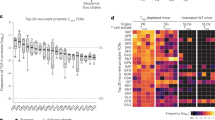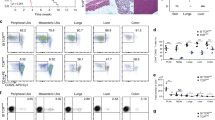Abstract
T LYMPHOCYTES bearing high-affinity T-cell receptors (TCR) for self-antigens are clonally deleted during thymus development1. Several recent studies1,4–10have identified variable domains of the β-chain of the TCR that are specifically deleted in vivo in mouse strains that express major histocompatibility complex class II molecules in addition to poorly defined self-antigens, including those encoded by the Mls-1a Mls-2a loci. Deletion of autoreactive cells in these systems occurs in the thymus, and antibody blocking experiments in vivo have implicated the phenotypically immature CD4+CD8+'cortical' subset as the target population for clonal deletion11,12. Similarly, studies with transgenic mice bearing autoreactive TCR have provided independent evidence that clonal deletion occurs at the CD4+CD8+ stage of development13. But none of these studies directly identified dying autoreactive cells, and the circumstances leading to deletion remain unclear. Here we report that neonatal thymus contains a significant popula- tion of phenotypically mature CD4+CD8−cells bearing autoreactive TCR. When placed in short-term culture, a large proportion (60%) of these autoreactive cells die selectively. Furthermore, their death can be prevented by inhibitors of macromolecule (RNA and protein) synthesis, as is the case for glucocorticoid-induced death of thymocytes2,3. These data indicate that physiological clonal deletion of autoreactive cells involves 'programmed' cell death, and that it can occur in cells with a mature (CD4+CD8−) surface phenotype.
This is a preview of subscription content, access via your institution
Access options
Subscribe to this journal
Receive 51 print issues and online access
$199.00 per year
only $3.90 per issue
Buy this article
- Purchase on Springer Link
- Instant access to full article PDF
Prices may be subject to local taxes which are calculated during checkout
Similar content being viewed by others
References
Kappler, J. W., Roehm, N. & Marrack, P. Cell 49, 263–271 (1987).
Wyllie, A. H., Morris, R. G., Smith, A. L. & Dunlop, D. J. Path. 142, 67–77 (1984).
Cohen, J. J. & Duke, R. C. J. Immun. 132, 38–42 (1984).
Kappler, J. W., Staerz, U., White, J. & Marrack, P. Nature 332, 35–40 (1988).
MacDonald, H. R. et al. Nature 332, 40–45 (1988).
Pullen, A. M., Marrack, P. & Kappler, J. W. Nature 335, 796–801 (1988).
Fry, A. M. & Matis, L. A. Nature 335, 830–832 (1988).
Tomonari, K. & Lovering, E. Immunogenetics 28, 445–451 (1988).
Bill, J., Kanagawa, O., Woodland, D. L. & Palmer, E. J. exp. Med. 169, 1405–1419 (1989).
Kanagawa, O., Palmer, E. & Bill, J. Cell Immun. 119, 412–426 (1989).
Fowlkes, B. J., Schwartz, R. H. & Pardoll, D. M. Nature 334, 620–623 (1988).
MacDonald, H. R., Hengartner, H. & Pedrazzini, T. Nature 335, 174–176 (1988).
Kisielow, P., Bluthmann, H., Staerz, U. D., Steinmetz, M. & von Boehmer, H. Nature 333, 742–746 (1988).
Schneider, R. et al. J. exp. Med. 169, 2149–2158 (1989).
Wyllie, A. H., Kerr, J. F. R. & Currie, A. R. Int. Rev. Cytol. 68, 251–305 (1980).
Shi, Y., Sahai, B. M. & Green, D. R. Nature 339, 625–626 (1989).
Smith, C. A., Williams, G. T., Kingston, R., Jenkinson, E. J. & Owen, J. J. T. Nature 337, 181–184 (1989).
Russell, J. H. Immunol. Rev. 72, 97–118 (1983).
McConkey, D. J. et al. Archs Biochem. Biophys. 269, 365–370 (1989).
McConkey, D. J., Hartzell, P., Nicotera, P. & Orrenius, S. FASEB J. 3, 1843–1849 (1989).
Ceredig, R., Dialynas, D. P., Fitch, F. W. & MacDonald, H. R. J. exp. Med. 158, 1654–1671 (1983).
Qin, S., Cobbold, S., Benjamin, R. & Waldmann, H. J. exp. Med. 169, 779–794 (1989).
Rammensee, H.-G., Kroschewski, R. & Frangoulis, B. Nature 339, 541–544 (1989).
Smith, H., Chen, I.-M., Kubo, R. & Tung, K. S. K. Science 245, 749–752 (1989).
Festenstein, H. & Berumen, L. Transplantation 37, 322–324 (1984).
Payne, J. et al. Proc. natn. Acad. Sci. U.S.A. 85, 7695–7698 (1988).
Haskins, K. et al. J. exp. Med. 160, 452–471 (1984).
Pierres, A. et al. J. Immun. 132, 2775–2782 (1984).
MacDonald, H. R. & Zaech, P. Cytometry 3, 55–58 (1982).
Author information
Authors and Affiliations
Rights and permissions
About this article
Cite this article
MacDonald, H., Lees, R. Programmed death of autoreactive thymocytes. Nature 343, 642–644 (1990). https://doi.org/10.1038/343642a0
Received:
Accepted:
Issue Date:
DOI: https://doi.org/10.1038/343642a0
This article is cited by
-
Molecular mechanisms of sulfasalazine‐induced T‐cell apoptosis
British Journal of Pharmacology (2002)
-
Role of Ca2+ in the Intracellular Signaling Pathway of Anti-IgM—Induced Apoptosis in the Human B-Cell Line, MBC-1, Established from Burkitt Lymphoma
International Journal of Hematology (2002)
-
Inhibition of nuclear factor kappa B and induction of apoptosis in T‐lymphocytes by sulfasalazine
British Journal of Pharmacology (1999)
-
The apoptosis and cell cycle changes of SUD4 and DOHH2 induced by topotecan
Wuhan University Journal of Natural Sciences (1998)
Comments
By submitting a comment you agree to abide by our Terms and Community Guidelines. If you find something abusive or that does not comply with our terms or guidelines please flag it as inappropriate.



